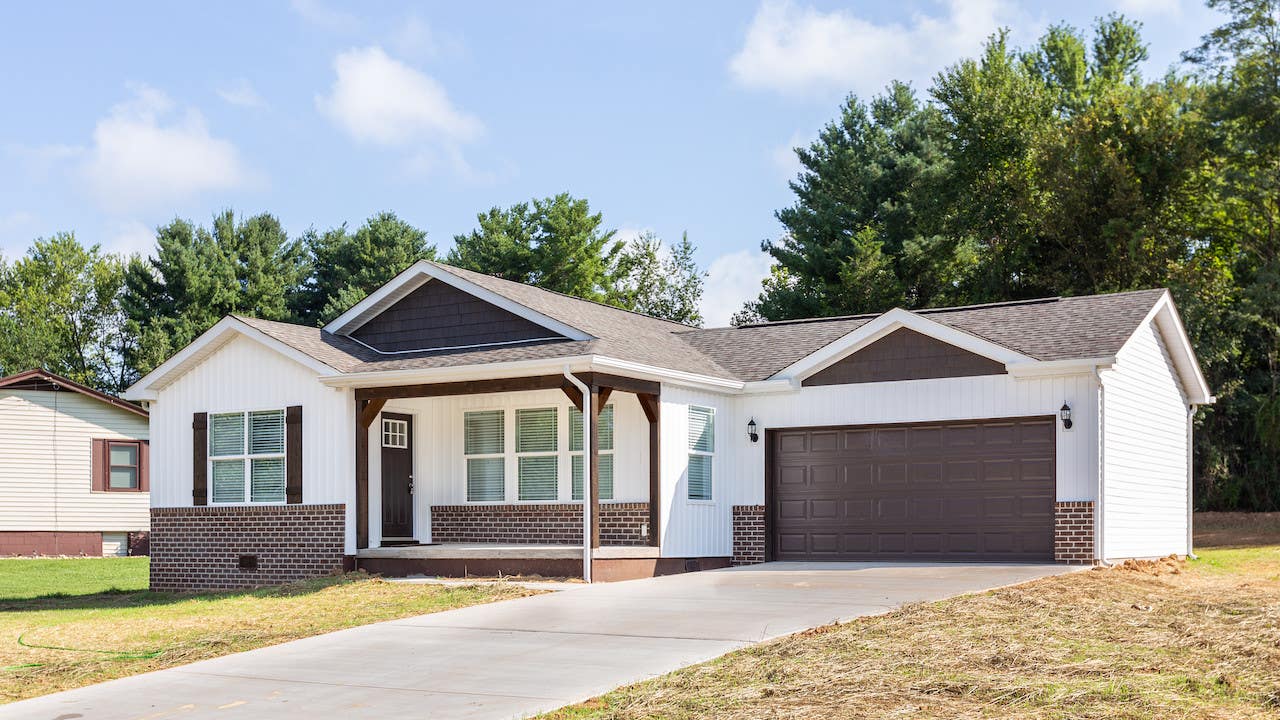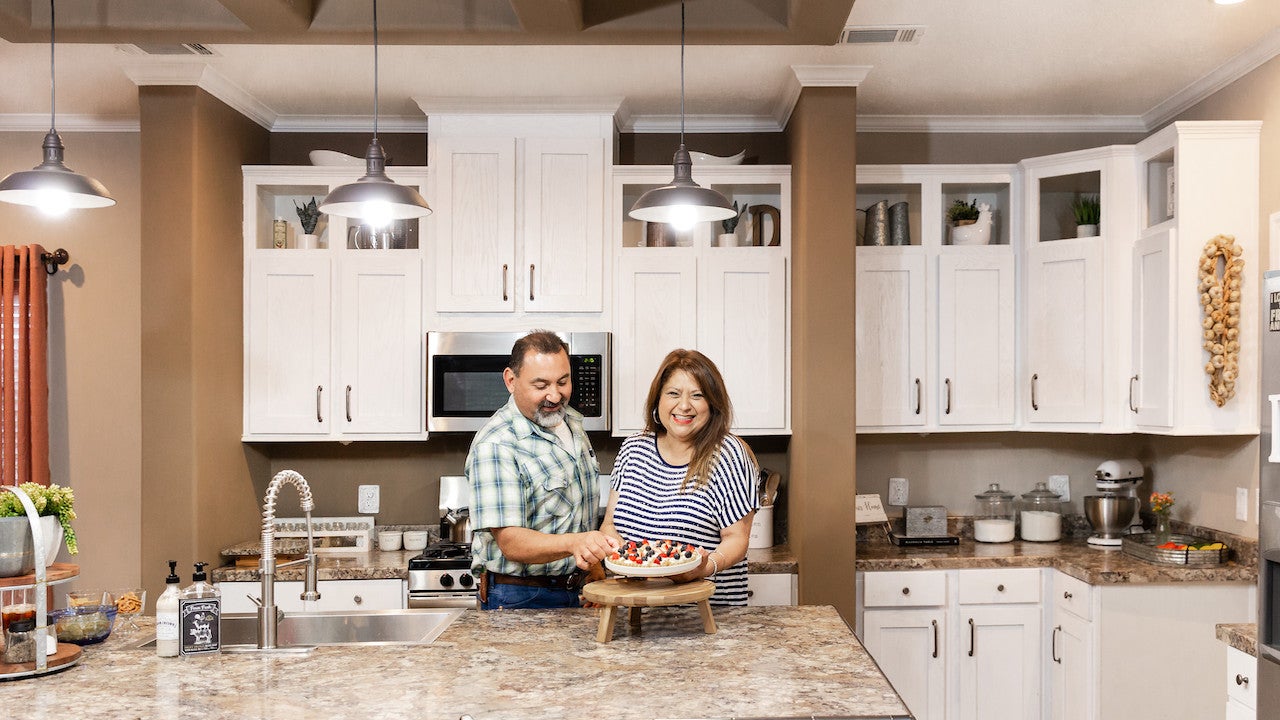As affordability squeeze tightens, manufactured homes could offer some relief

The Bankrate promise
At Bankrate we strive to help you make smarter financial decisions. While we adhere to strict , this post may contain references to products from our partners. Here's an explanation for .
When Moraima and Roland Duran researched what type of home to build on their three-acre lot north of Austin, Texas, the couple was pleasantly surprised by the range of choices offered by a new generation of manufactured homes.
The Durans once lived in a small trailer on their lot. They found today’s prefab options far more appealing: The couple was able to customize a 2,100-square-foot model to include fireplaces, a room for their dogs and front and back porches.
“The quality of the homes from years past had really upgraded,” Moraima Duran says.
Because their manufactured home met the same building standards as a site-built home, they were able to finance the purchase with a Federal Housing Administration mortgage.
Amid a historic housing boom, one that’s pushing homeownership out of reach of many Americans, manufactured housing presents a partial solution to the affordability squeeze. Makers of manufactured homes have raised their game in recent years, and mortgage giants Fannie Mae and Freddie Mac have responded by backing mortgages on higher-end prefab homes.
“When you look at the quality of our construction, some people think that we’re talking about grandma’s trailer, and that’s clearly not what we are producing today,” says Lesli Gooch, executive director of the Manufactured Housing Institute, an industry trade group.
Prefab homes are no cure-all for the housing shortage – many municipalities don’t allow manufactured homes, financing can be tricky and consumer perceptions about old-school single-wide trailers die hard. But proponents of manufactured housing say the property type offers at least some relief to the nationwide shortage of homes.
A cheaper way to build a home
The Durans bought a model from Clayton Homes that started at a base price of $198,000. After adding options, the price ballooned to $300,000.

The Durans in their kitchen.
The savings come because, compared with painstakingly constructing a house on a vacant lot, it’s more efficient to build a house in a factory and then quickly assemble it on site. Traditional houses are built from the ground up by teams of subcontractors, and work unfolds over the course of months.
Manufactured homes, by contrast, are built in factories and then delivered by truck to the homeowner’s lot and assembled in hours. The quicker process cuts costs by increasing efficiency and speeding construction timelines.
“Manufactured housing offers substantial cost savings over traditional stick-built homes in places where land costs are relatively low, because it reduces the construction labor and materials costs,” writes Jenny Schuetz, a fellow at the Metropolitan Policy Program at Brookings, in her new book, Fixer-Upper: How to Repair America’s Broken Housing Systems. “This would be especially helpful in rural areas or cities with a high incidence of vacant lots, such as Detroit or Baltimore.”
Land costs matter because the price of dirt is perhaps the biggest factor driving regional differences in home prices. The median price of a single-family home in San Jose, California, was $1.65 million in the third quarter of 2021, the National Association of Realtors says. In St. Louis, the median home price was $235,700. It doesn’t cost $1.4 million more to build a home in San Jose; it’s just that land is so much more expensive. So manufactured homes are unlikely to make a dent in the affordability squeeze in the most expensive markets.
Challenges remain
Despite the cost advantages, manufactured homes remain an overlooked and unloved corner of the housing market. More than 21 million Americans live in manufactured homes, the Manufactured Housing Institute estimates, but the property type remains saddled with stereotypes.
“One of the challenges we are having is the stigma around our homes,” Gooch says. “When people hear manufactured home, they think of mobile home. They think of trailer. They’re not thinking of the type of homes we’re building today. We need to overcome that impression that people have.”
Those negative impressions are deeply rooted. Many consumers, real estate agents, lenders, appraisers and housing economists associate manufactured housing, to one degree or another, with low-value properties in undesirable areas, a recipe for depreciation rather than appreciation.
Safety concerns are another issue – the Durans’ long-ago trailer burned down back in the 1990s. And early generations of mobile homes lacked the weather resistance of today’s hardier models.
Manufactured homes gain momentum
In a recent surge of attention, the affordability crunch has focused new attention on factory-built homes. Gooch, head of the Manufactured Housing Institute, addressed members of the National Association of Realtors, the nation’s largest trade group, in a webinar.
And the Lincoln Institute of Land Policy in January urged Fannie and Freddie to finance more manufactured homes as a way to help more Americans afford homes. The recommendation came in part because makers of manufactured homes are building higher-quality products, says Jim Gray, senior fellow at the Lincoln Institute.
“In the last few years, the industry has shifted toward building homes that are indistinguishable from site-built homes,” Gray says.
How to finance a manufactured home
Getting a traditional mortgage on an old-style mobile home is nearly impossible. That’s because many of the homes are situated on lots that residents lease rather than own. Mortgages generally aren’t available in that scenario, leaving homeowners to take “chattel loans” rather than traditional home loans.
However, the new generation of manufactured homes – known in the industry as “CrossMod” homes – are eligible for mainstream mortgages. That’s because the newer homes are built to stay in one place and to meet the same safety standards as site-built homes, and because homeowners often own the lots under the homes.
This new breed of manufactured housing is eligible for a mortgage through Freddie Mac’s CHOICEHome program and through Fannie Mae’s MH Advantage initiative. The Federal Housing Administration and the U.S. Department of Veterans Affairs also makes loans on higher-end manufactured homes, so long as the borrower owns the land.
How to buy a manufactured home
- Find a location. Site selection is the first step. Decide whether you’ll rent or own the land. Keep in mind that leasing the lot gives you fewer financing options. If you buy a lot in a manufactured home community, you can feel confident that the housing type is allowable under local zoning codes. If you’re looking at land outside a community of prefab homes, make sure local rules allow manufactured homes.
- Shop for a manufactured home. Look at the variety of manufactured homes available. The process can be similar to picking out a site-built new home or even a new car – you can go with the off-the-shelf model, or you can customize it to fit your needs.
- Lock in a loan. Now it’s time to find a loan. If you own the land and you’re investing in one of the higher-end new mobile homes, you should be eligible for a mortgage through Fannie, Freddie, the FHA or the VA. Check with lenders, a mortgage broker or the company selling your manufactured home to see which type of loan best fits your situation
- Prepare the lot. The maker of your home will work with you to make sure the dirt under your house is ready to go. This includes such steps as applying for permits and preparing utility connections.
- Schedule delivery and installation of your home. Once the financing is lined up and the lot is ready, the manufacturer of your home will deliver and install the home.
Learn more:
Related Articles


Buying amid affordability squeeze? Here’s how homebuyers can cope

‘Missing middle’ homes could ease affordability squeeze, architect says

‘Missing middle’ homes could ease affordability squeeze, architect says